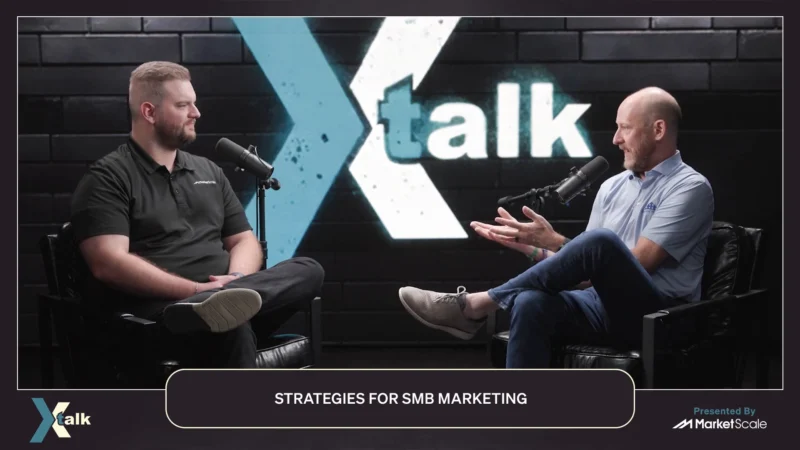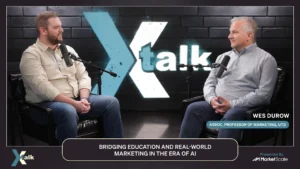Bringing AI to Businesses Ep. 1: How Do You Make AI Useful for your Business? with Ben Taylor
This is a MarketScale Software & Technology Podcast Series, hosted by Daniel Litwin. This is the first episode of a three part series titled Bringing AI to Businesses with Ben Taylor, Chief AI Officer & Co-founder of ZIFF Inc. In each episode, we’ll explore different aspects of AI’s push into business-operations ubiquity, from its most useful applications to the surprising business ethics that come with implementation. Each episode will also feature a short article from Taylor, which you can read below.
Why Most Companies Are Not Prepared For The AI Season Change
Artificial Intelligence is a strange beast for established businesses dealing with digital transformation. How much is hype, and how much could impact their current market and growth? Many executives are not taking this new technology seriously enough, and are naive with existing capabilities. They see issues with self driving cars, and AI assisted medical contracts being canceled. They hear about impressive feats from companies like Google beating humans with AlphaGo, or beating an entire team of humans with the video game Dota-2. These AI wins seem “cute” or “toy” to business executive;, they can’t relate to them or see how they might be applied.
The calm sense that AI actions can be procrastinated further is dangerous for businesses. There are some real “land-minds” out there showing up in the market that should scare any savvy executive. In 2016, Google’s DeepMind AI team reduced their data center cooling cost by 40%. A modest decrease of 5-10% is impressive; a decrease of 40% could shock and disrupt a market. There are also “expert-killer” applications coming online overnight that are replacing the smartest humans on the planet with AI. Examples of these exist in linguistics, emotion reading, phonetics, manufacturing, and even medicine.
Checking The Data Scientist Box Isn’t Enough
Some executives naively think that by hiring a data scientist, they have invested sufficiently in their company’s future. The problem with this approach is most companies are unwilling to pay the high salaries of $200-400K/yr for a senior experienced data scientist; they settle for an entry level recruit, or maybe even a new college graduate. This approach sets companies up for longer time scales before value is realized (12-16 months), and increases their risk of failing to find significant value. To help maximize success, companies should err on hiring a more experienced data scientist who has shipped value into production. Also, leveraging outside AI platforms, consultants, and partners to quickly vet ideas and projects can help.
Full Executive Buy-in
Data scientists are notorious for working on the wrong projects. If left alone they will spin circles and hyper-focus on difficult, non-value-add problems. The best AI project suggestions we have seen have come directly from the executive team. They understand which projects could offer the business the most value, and they hold the AI researchers accountable. One major challenge between the business and data science units within a business are the communication gap. Data scientists attempt to educate their business counterparts on AUC scores, r-values, and validation sets rather than delivery results and recommendations in a business friendly way. One thing that I have grown to appreciate it is the number of high priority items these managers and executives are juggling. They have no time or interest knowing how the data scientists got from A to Z, they just want the final recommendation. Data scientists do this hoping to convince others of their technical capabilities or to get partial credit for their hard work on a problem. A number with a dollar sign is always best when delivering results to an executive.
Suspend Your Classical Thinking For A Minute
Many businesses get stuck in a rut where they are trying to produce “intermediate” variables; they are attempting to predict data that humans have understood about a problem. Take predicting the price of a home for example. A human might decide that a swimming pool is a useful item to know from an image. Humans are limited with feature discovery and understanding, so when it comes to images, audio, or video, we see the best results when the AI is unconstrained on finding what matters. Given the choice between predicting an intermediate variable and the final outcome that matters (e.g. the price of a home), always focus further downstream. Intermediate variables can be used for storytelling or model insight, but by themselves their value is limited. Harnessing the full power of AI really allows you to unlock new insights and features on your problem.
If you have questions or comments about why businesses struggle with AI, and how to best approach testing the waters, let us know on social media.
HIGHLIGHTS FROM THE EPISODE
Daniel Litwin: As a data scientist presenting this information to the executive, you need to make sure that it’s easy for them to be able to see the insight from the get-go. Like you said, if you’re even having to spend the time educating them on what each piece of data means, it’s already too late, like that shouldn’t really even be part of the conversation. That needs to already be presented in a way that is looking at, “Okay, this data is going to affect this KPI. It’s going to decrease costs here. It’s going to increase costs here. It’s going to increase revenue here,” without you saying like, “All right, here’s some data. Go ahead and interpret it however you see fit and make some changes.” I think the data scientist almost needs to consult as well.
Ben Taylor: Well, the other thing that’s happening, and I’ve fallen into this trap, the data scientist wants to get partial credit. So they’re showing you their work, they’re showing you these customer plots, they’re showing you all this insight. The executive doesn’t care about any of that. They just want to know. If anything, that actually increases their doubt that this data scientist really doesn’t know what’s going on because they’re not giving me a clear recommendation. They just want the recommendation. They don’t want to understand how you got there. They don’t want to understand the partial credit. And then getting back to Mark Newman, so I love that email response, another thing he said to me later on while I was going through this transition is one point he said, “Ben, we know you’re smart that’s why we hired you. You don’t have to keep reminding us.” And the thing I love about these little one-liners is they’re very focused on what the priorities are.
So walking you through the journey, how I got from A to Z and kind of my understanding and maybe fishing for partial credit is not useful. You need to get to the point and have the recommendation, and then the other surprising thing is any number you request from a data scientist, you can expect some of the better data scientists, they know how to put a confidence around that number. So if I’m telling you I’m going to increase click through rate or something, I should be able to give you a confidence range on the projected increase, but that’s actually not helpful. Anytime you talk about partial credit or a confidence bounce, it actually decreases the confidence in the businessperson that you’re trying to communicate with. It’s much better for you to just have that recommendation and use your statistical insight to kind of back it and just get to the point.
DL: Yeah. Yeah. I mean that definitely makes sense. So let’s dig into some of the actual beneficial applications of AI for a business. I think often what ends up happening is if a business even adapts AI into its operations, the data scientists maybe or whoever is in charge of saying, “Okay, we want these processes automated,” or, “We want to get some insight out of this,” there is not a tangible correlation between that and any sort of measurable or quantifiable information. How can you quantify said thing? So that’s what I want to break down here is, what are some of these projects that are supposedly useful for a business but end up being nonessential? And then what are some AI projects that are actually beneficial for a business? And we can walk through some examples.
BT: Yeah. So this is a fascinating topic because… I feel like I always like to come up with these analogies to force on the topic.
DL: Got to love analogies.
BT: Yeah. So there are kind of two camps of people. So there are people in the know and there are people that are not in the know. And what I mean by that is understanding the true state of AI today. And so if you talk to a lot of businesses and executives, they’re not in the “know camp.” They’re pretty naïve when it comes to capabilities. And if anything, they’re actually thinking that AI is less capable than it is today because they look at things like self-driving cars, cancer research… we still have cancer and we don’t have self-driving cars. They kind of see this ultra niche play where eventually something interesting might happen with their business, but today it’s not there, it’s not ready. But at the same time, we can give examples of very, very scary things for businesses that are happening overnight.
So the thing I love to bring up is you have… so to simplify this, let’s just say there are people out there that are the smartest humans on the planet. They’re Ivy League educated. They’ve dedicated their entire career to a very specific domain. So that might be linguistics, so understanding the meaning behind the English language, what you say means this and that. They might be emotion analysis. So Ekman, he understands your facial expressions, what they mean. He does consulting for the FBI. The show “Lie to Me” was inspired after him. You have automatic speech recognition experts that are coming out of Oxford. They’ve been rock stars for the last two decades. They demand very high salaries. They understand the theory behind phonemes and parts of speech, stuff coming from the movie My Fair Lady, but matured into the tech space. And then you have physicians, radiologists, pathologists, dermatologists.
So you have these people, they are much smarter than you and I when it comes to their domain, but we’re seeing examples where these experts are almost blindsided overnight with AI. So with linguistics, you would be a fool to pay for products coming from these human experts because AI can… and we actually did these studies. This was one I was involved with a few years ago. We’re benchmarking the best humans on the planet for breaking down language. So you said this, it means this. So what they do is they take everything you said and they bucket it in a multiple categories and you can use that for hiring. You can use that for persona targeting with advertising. There are a lot of use cases that are really interesting.
The performance and the value we got from the human expert features was embarrassing compared to the AI features where you take a billion words, the computer reads them, understands the language relationships, and then it just invents its own topics and the topics were way more productive and that we’ve seen that with emotion, we’ve seen that with speech recognition, and we’re seeing that now with the medicine. And along the way, there’s lots of resistance. But if this is your industry, you could feel very comfortable today that AI is not impacting your industry and you could be in a state of desperation in a couple of quarters because one of these applications actually hits the market and you’re blindsided with automation.
So there are lots of examples. They’re kind of slow. Manufacturing is a little slow, but you can see lots of the use cases in keyway, quality inspection and manufacturing. There are lots of industries getting wins, but there are also industries that are having some missteps in AI.
DL: Right. And I mean looking at a major company that was able to implement AI to drop the bill down by a big number, we saw Google actually find ways to create more efficient ways to cool their data centers and that was accomplished through AI. They were able to reduce the bill by 40 percent, which is huge. DeepMind accomplished that which is fabulous. So you can literally see that AI will impact your business in a positive way. It’s just finding those applications whether it is in something like, yeah, reducing your carbon footprint or whether it’s increasing the efficiency of your manufacturing plant.
Some of those processes I think feel a little more intuitive. I think it’s when you get to some businesses that don’t have some of those industrial level processes and they look to you, “Okay, where is AI going to actually benefit me? Do I use it to track social media engagement? Do I use it to track the way people are purchasing my items where if not applied correctly, it can be a waste of money and a waste of time?”
BT: Yeah. And it can even be worse than that because it can waste time and money, but it can actually kind of leave a bad taste with the executive team and the businessperson that sponsored that effort where now they are less likely to have AI in production in the next two years. So I’ve warned people that if they don’t feel like their first AI project is useful, like dramatically useful to the business, I would recommend waiting. So don’t burn political capital on a science project. Wait until you have a clear line of sight on a business plan and then do something because if you work on a hard project, it’s going to be really hard for you to get buy-in for hardware and talent when you actually find something that’s useful. So it’s like The Boy Who Cried Wolf. We tried the science project, waste of time. We tried this science project, waste of time. Now I need to increase click-through rate or some type of automate a human step. I mean I have no confidence that IT directors or the CTO are going to succeed the third try.
DL: Right, exactly. You don’t want to bring a bad name to the ability of AI because when applied correctly, it can be transformational for the company.
For the latest news, videos, and podcasts in the Software & Electronics Industry, be sure to subscribe to our industry publication.
Follow us on social media for the latest updates in B2B!
Twitter – @TechMKSL
Facebook – facebook.com/marketscale
LinkedIn – linkedin.com/company/marketscale








